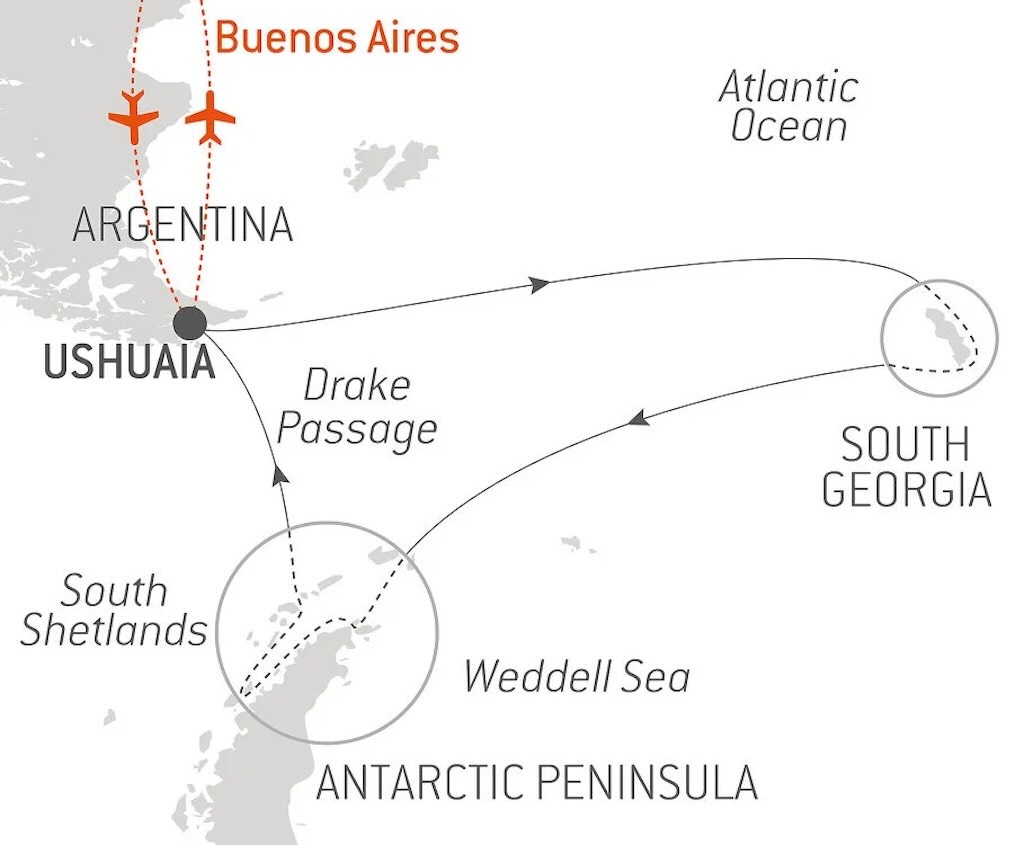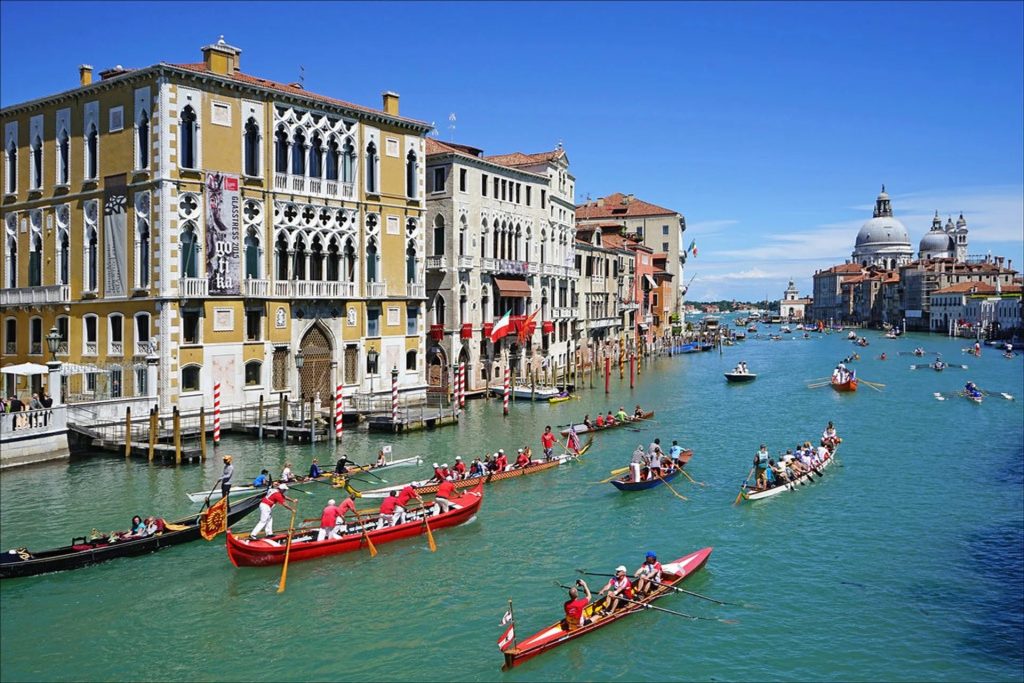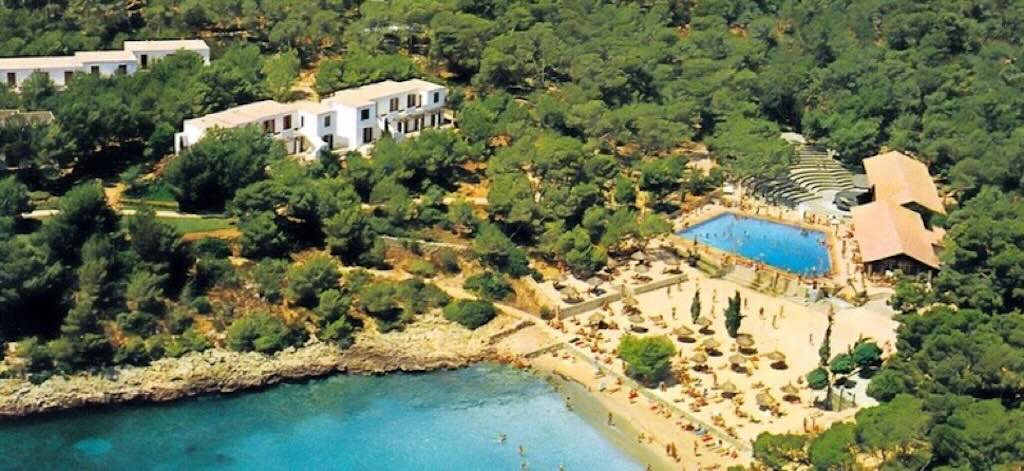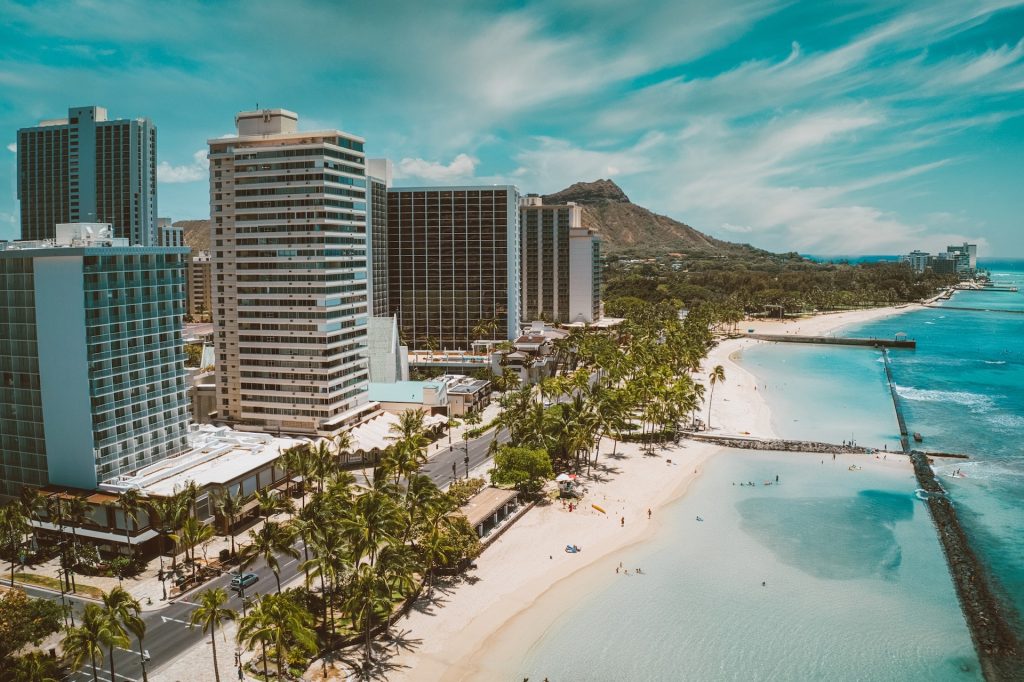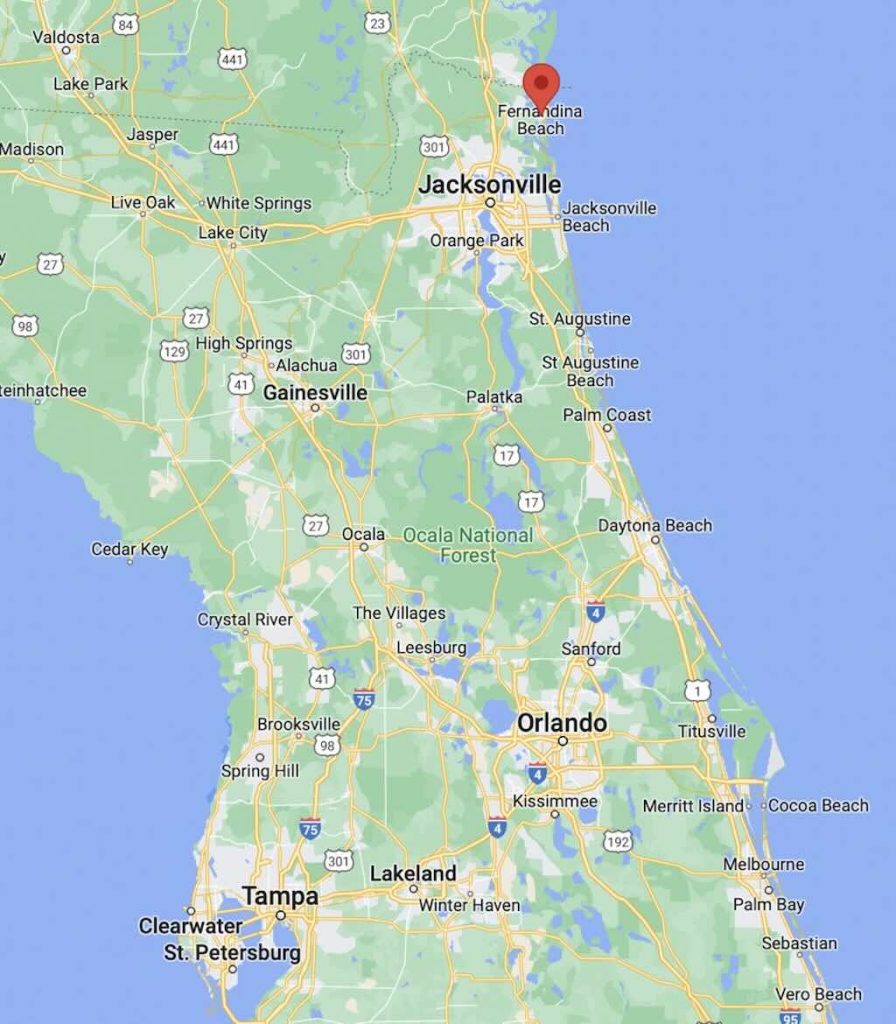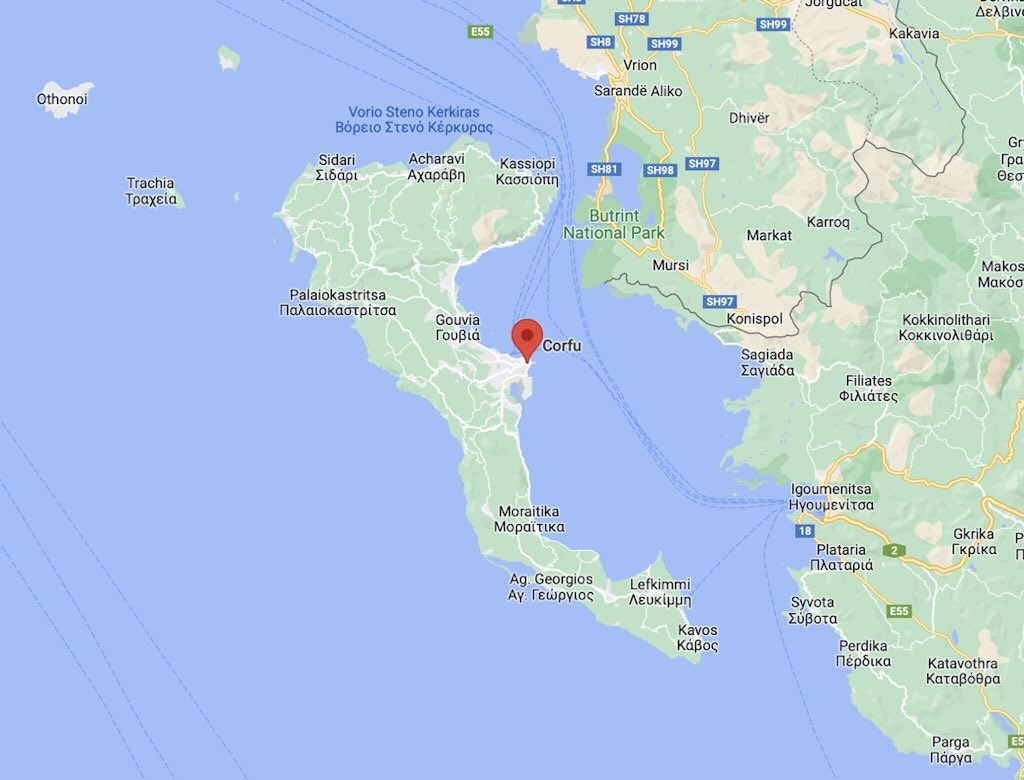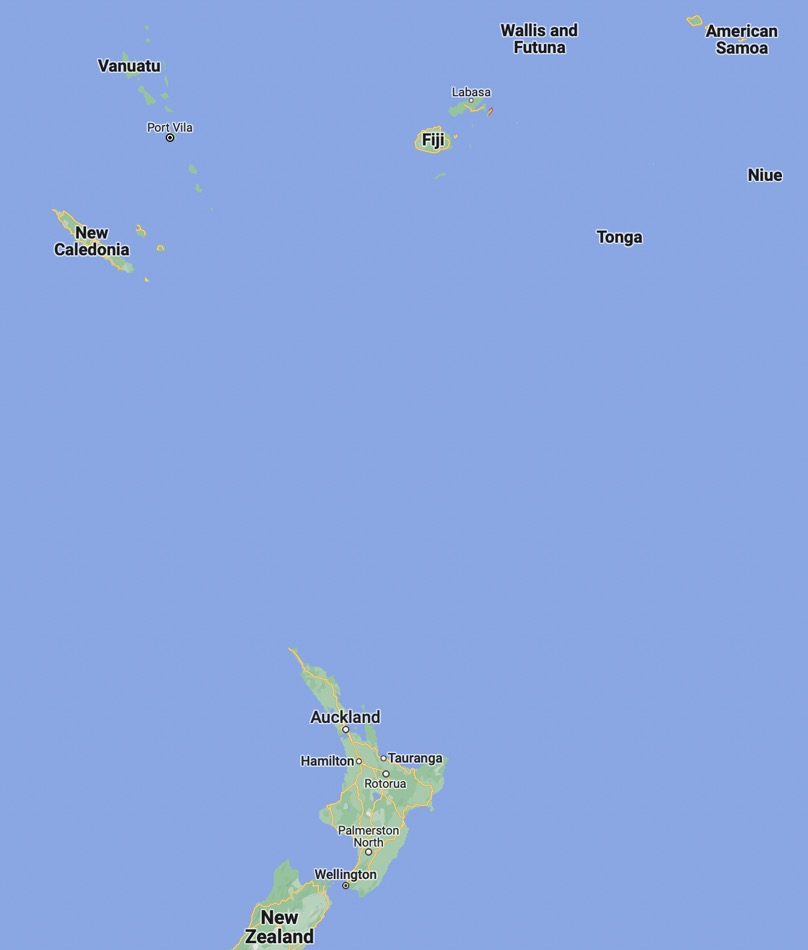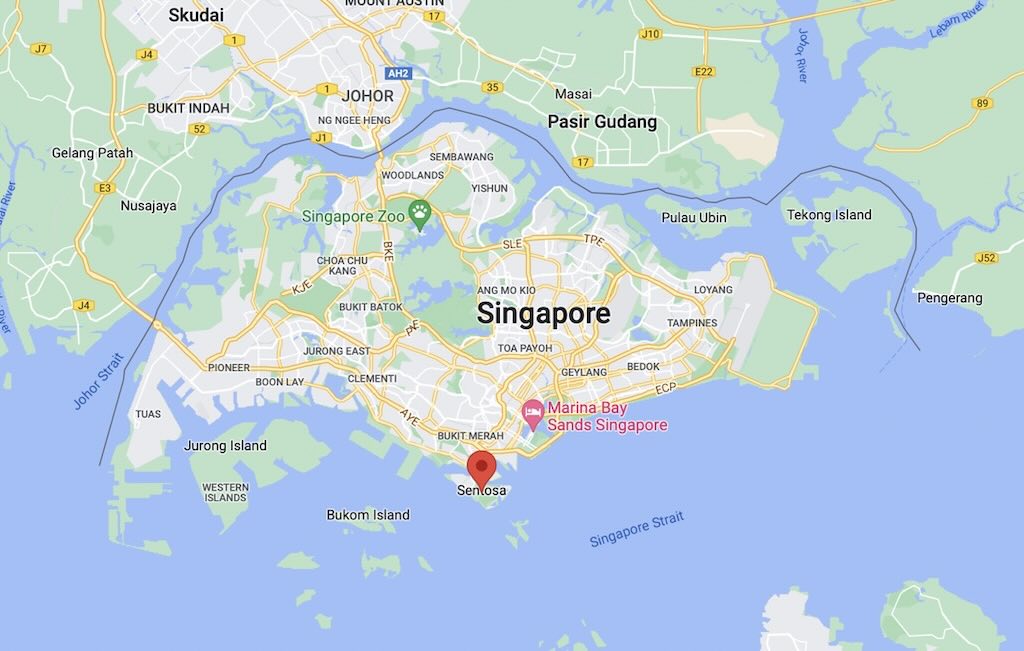In December 2023 the light of my life, Monique, passed away. It was, and will always be, the most traumatic experience of my life. And it left me in a kind of limbo. How could I evolve a completely new “life view” for myself, whilst trying to understand how to live everyday with the memories of 49 years spent together?
One small facet of my new life was the desire to continue to travel, but only to places where my beloved wife would never have want to go. We had travelled extensively together, but I knew that my wife would never have visited places such as the Antarctic. She hated the cold, and was not particularly attracted to the idea of long-distance flying nor life on a cruise ship.
Researching background for this trip I did not realise that “bragging rights” was so important for some people when “visiting the seven continents”. So going to the Antarctic through Buenos Aires will clock my seven. Do I care, not really.
This post is focussed on basic planning tasks. I start with why I decided on the Antarctic, then how I picked the cruise, then booking flights and hotels, etc.
Why the Antarctic?
Where could I go? There were a couple of places my wife and I might have visited, but didn’t. And there were places where I knew that my wife would never have visited. Too remote, too cold, too hot, too boring, too physically challenging, too dangerous, etc.
The idea of the Antarctic emerged in part because two friends had made the trip, and had come back praising the “otherworldly” experiences they had. And both family and friends had often lauded praise on the whole idea of cruise holidays as a way to visit the world.
In addition, it just so happened that there was also a French TV programme showing about the same time, on an explorer cruise to the Antarctic.
I picked up two Antarctic cruise brochures from my local travel agent, one from Ponant and the other for Hurtigruten. I also checked out the online cruise resources such as Vacations To Go and www.cruise.com.
What became evident was, firstly, that you had to plan ahead, and book well in advance (often 12-18 months in advance).
Secondly, not all cruises were economically attractive, because when travelling alone some companies applied prohibitively expensive “singles” rates. However, certain cabins on certain ships, at certain times, were exempt, totally or partially, from this “singles” levy. And of course, cruising in the Antarctic region was also seasonal.
Thirdly, selecting a smaller explorer-style ship meant that there was increased pressure to book early.
And last, but not least, trips actually visiting the Antarctic Peninsula were said to be quite challenging for “elderly people” (an expression I reject completely). But it was another good reason to quickly plan and book, “before it was too late”.
Picking the right type of cruise and the right cruise company
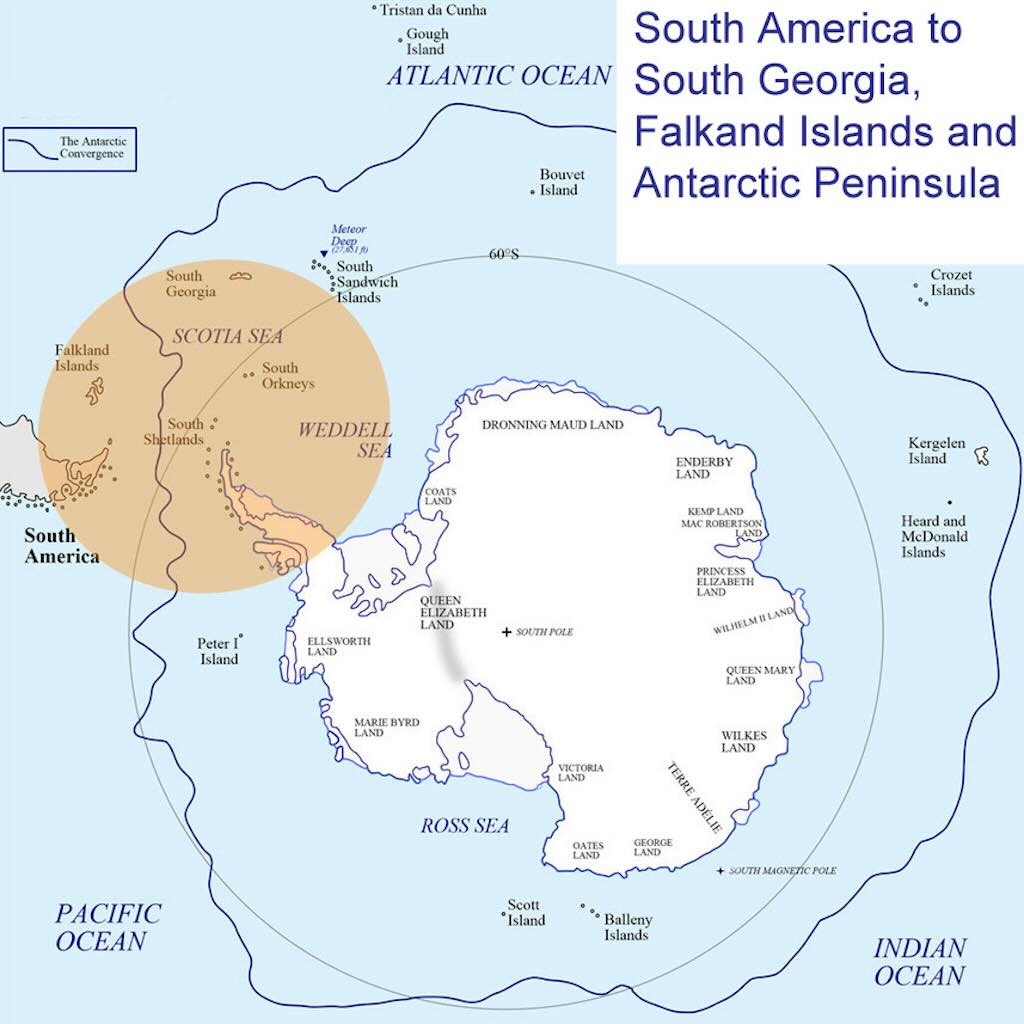
I picked a Ponant cruise that includes a flight from Buenos Aires to Ushuaia, followed by a 16-night cruise to both South Georgia and Antarctic Peninsula, crossing both the Weddell Sea and the Drake Passage. The route is shown in the feature image on this posting.
What first surprised me, as a neophyte about both cruising and the Antarctic, was the multitude of options.
The best place to start is with the International Association of Antarctic Tour Operators, which lists the vessels that make Antarctic tours. These vessels can range from 10-12 passengers (plus a crew of two) to more than 3000 passengers (plus 1000 crew members). Given that there is an agreed limit of 100 passengers and crew ashore at any time, it’s obvious that smaller vessels permits more passengers to spend more time ashore. I also understood that the mega-cruise ships had no landing rights at all, and could just cruise nearby.
I then found Cool Antarctica, with the page “Antarctic Cruise and Travel Guide“, which was extremely useful. This is a really rich site listing everything from Antarctic history and animals to recommendations for clothing and footwear.
What we see above is the area visited by many cruises lasting between 15 and 24 days. Most include 2 days to get to South Georgia and 2 days to cross the Drake Passage. Some cruises will actually cross the Antarctic Circle, others might include the Falkland Islands, and yet others might just visit South Georgia and the Falkland Islands. There are also 10-12 day cruises that just sail directly to the Antarctic Peninsula, and these trips can be combined with a fly-sail or sail-fly, or even be replaced by a fly-fly option out of Ushuaia (saving 4 days of crossings). There are also 26-30 day cruises from New Zealand or Australia, but they visit a different area of the Antarctic.
The destinations and duration often limits the number of cruise options, e.g. not all companies offer cruises to the Falklands, South Georgia and Antartica.
It is possible to actually fly to the Antarctic and holiday at the South Pole (but it’s a bit extreme).
The option to fly over the Drake Passage as opposed to sailing through it, makes for a completely different type of experience. For many people sailing through the Drake Passage is the whole point of the trip, it’s a “rite of passage“.
It was also noted that bad weather can make sailing the Drake Passage unpleasant, but it can make flying impossible. A visit to the Antarctic is more likely to get cancelled due to not being able to fly, than not being able to sail. In addition the fly-the-Drake season is generally shorter than the sailing season because they have to make sure the runway aren’t iced over.
It’s important to realise that this type of polar exploration trip is unlike most cruise vacations. For many passengers the ship itself and its amenities are secondary when it comes to going to the Antarctic. The ship is a means of transport and not a luxury vacation in itself. Passengers are more interested in the on-board sessions to learn about the history, biology, and ecology of the Antarctic, and not about fine-dining options or the availability of a heated pool and a selection of massages.
What the reviews said
I guess the first point was to look at the month of November. November is the very start of the Antarctic tourist season. Summer is just beginning and the abundant wildlife becomes more active. The days are still cold though and temperatures are generally below freezing. Large ice floes and glaciers still remain in November creating some incredible natural ice sculptures. A November cruise usually continues into December, which gets a bit warmer thanks to more daylight around the solstice (21.12.2024). The weather in the Drake Passage in December also offers an increased chance for calmer seas.
But Antarctica’s weather is notoriously unpredictable, and November is no exception. Although calmer than the winter months, there’s still a risk of travel-disrupting blizzards and sea ice that hasn’t yet receded.
Average temperature in Antarctica in November is -4°C to 0°C with around 15 hours of daylight. However temperatures can vary widely, and can drop to -15°C. Average temperature in December is -2°C to +1°C with more than 16 hours of daylight.
Extensive snow cloaks Antarctica in a ‘pristine whiteness’. Sea ice is still prevalent and at its most impressive. Pack ice begins to melt, opening up the 18 million square kilometres of the frozen Southern Ocean. Glaciers are actively calving as temperatures rise.
The penguin populations in the rookeries grow, and the birds are busy nest-building and courting. Adélie, Chinstrap & Gentoo penguins find mates, build nests and lay eggs. King penguins on South Georgia Island lay eggs & incubate on their feet by late November. Weddell and Fur Seals are busy mating, while in South Georgia Elephant Seal beach and patrol their recently won harems. Albatross, Marine Fulmars and Petrels fly the Drake Passage while Blue-Eyed Shags return to Antarctica.
Whales beginning to arrive in December. Fuzzy brown King penguin chicks are hatching on South Georgia Island. Leopard, Crabeater, Weddell & Elephant seal pups are commonly seen on ice floes.
Early season prices (November) are often the lowest of the year.
Detailed reviews include Exploring the Chilean Fjords on Ponant L’Austral, Antarctic Perfection Aboard Le Boreal, Almost Beyond the Polar Circle and Le Commandant Charcot Review, on Cruise Critic (long, extensive reviews).
In fact websites such as Cruise Critic, CruiseMapper, and Shipmate, are a great source of background information, and there are some very useful videos on YouTube. I viewed videos such as Antarctica – Boat Time Lapse (Feb 2018) – Polar Pioneer, Antarctica Cruise on Ponant Le Lyrial with Abercrombie and Kent and Life on Board Le Lyrial. There are even playlists such as Ponant’s Le Boreal Antarctica Cruise, which includes 25 videos on one persons trip.
Antarctica Trip Report (2018) is another report of an Antarctic trip with Quark Expeditions, but this time flying out from Chile. And this is a report of an 18 night cruise to the Falkland Islands, South Georgia and Antarctica taken in February-March 2020. Here is a trip report on “Ski touring in the Antarctic” on the Sea Adventurer (now called Ocean Adventurer), which is part of the Quark Expeditions family of ships chartered by Ice Axe.
One of Argentina’s best travel bloggers is Sir Chandler, who really focusses on Argentina. And the Buenos Aires Times is a local English language news source.
I booked with Ponant
I made my initial enquiry late February 2024, and confirmed my booking in early March 2024. Payment was completed in June 2024, and I started to receive targeted requests concerning the formalities, e.g. request for contact details, etc.
By the end of August Ponant required a formal confirmation that I had read their information note on the conditions for embarking on the cruise, e..g health considerations, etc.
They also asked for additional travel details concerning my flights (separately booked) and where I was staying in Buenos Aires before and after the cruise.
There was also a “tool” to check on the visa situation. I did not require a visa, but my passport had to be valid more than 6 months following the cruise, and have two full pages completely free.
In mid October 2024 I received “travel documents“, and 10 days before departure I received a “we can’t wait to welcome you on board”.
More about the Ponant cruise
In the Terms and Conditions specific to the winter 2024-2025 the following basic itinerary was outlined.
The package started with 1 night in a 4-star hotel in Buenos Aires, including dinner with drinks.
Breakfast and group transport to airport, and charter flight (economy) to Ushuaia.
Lunch in Ushuaia and group transfer to the ship Le Lyrial.
The return trip included breakfast, group transport to the local airport and a charter flight back to Buenos Aires.
This itinerary was a standard format, and was replaced by a far more detailed itinerary about 6 weeks before departure. In no way did the finally itinerary contradict in a negative way the initial one.
Conditions and constraints in booking the cruise
In the booking confirmation there was a specific reference to the need to “read carefully” the Terms and Conditions as well as the “boarding conditions”. In addition it was stated that I might receive a separate medical form.
I guess “might” meant “will”, and I saw in one of the videos passengers signing and giving in their forms.
In the specific conditions it was noted that any visa costs, “Spa and Wellness” (with advanced booking), scuba diving, trips in kayak, washing clothes (no dry cleaning available), etc., were not included.
There was a mention that a polar parka and the rental of a special pair of boots were included.
The currency onboard was the €.
One particular point was that travelling to Buenos Aires might include a baggage allowance that exceeded the allowance for the economy flight to Ushuaia (15-20 kg and 5 kg in cabin were mentioned), and this might incur supplementary charges or even a refusal.
There was also a reminder that appropriate clothing, sunglasses, waterproof bag, etc. would be needed, plus a pair of binoculars was recommended.
There was also a reminder not to travel with valuables, and a cryptic message to adapt one’s comportment to the destination in question.
In addition to the above specific conditions, there was also a 19-page set of general conditions.
I noted that baggage had to be correctly labelled, with complete name, the name of the ship, the destination and number of the cabin.
There was also a long list of things that were forbidden on board. It was the usual list seen for air travel, plus a few oddities, namely flat-iron, water heater, coffee machine, rice cooker, hoverboards and scooters, compressed air, drones, radio-navigator, laser pointers, Samsung Note 7, candles.
There was a recommendation not to leave things on charge during the night.
There was a reference to the availability of a safe in the cabin, and that the contents should be accompanied by an inventory list.
Boarding conditions and passenger fitness
It did sound a bit better in French with “aptitude du passager“, but the key messages were:-
I have to be “both physically and psychologically able to stay for several days at sea closed in a cruise ship”.
I have to be fit enough to embark and disembark at ports of call or on boat excursions.
I have to respect crew orders in case of bad weather, etc.
Clearly one important aspect was that medical and hospital treatment would be problematic. The warning was stressed even more so for those people with certain pre-existing medical conditions (a long list was included covering everything from limited autonomy through to chronic cardiac, renal or respiratory insufficiencies, or even insulin-dependent diabetes).
As proposed by Ponant I did take out their travel insurance and repatriation policy.
Travel sickness
Travel or motion sickness was mentioned numerous times, and in particular with the crossing of the Drake Passage, one of the most treacherous voyages for ships to make.
Seasickness is characterised by a feeling of nausea and, in extreme cases, vertigo experienced after spending time on a boat. The greatest contributor to seasickness comes from the rolling or surging motions of the boat. Around 80% of the general population is susceptible to medium to high motion sickness.
Lying on the back, listening to music, “mindful breathing”, and not reading while moving are said to help.
Most travellers mention medications, usually antimuscarinics such as scopolamine, or H1 antihistamines such as dimenhydrinate. Benefits are greater if used before the onset of symptoms or shortly after symptoms begin. It should be noted that a number of medications used for nausea such as ondansetron and metoclopramide are not effective in motion sickness.
Scopolamine was often mentioned as being the most effective medication, in particular as a skin patch.
The problem was that certain types of medication were not known or available in my local environment.
What I found were:-
Agyrax (meclizine) – is a histamine H1 antagonist used in the treatment of motion sickness, vertigo, and nausea (often during pregnancy or for radiation sickness). It acts in the bronchi, capillaries, and some other smooth muscles, and is also used to prevent or allay motion sickness, but can induce somnolence.
Vomex A – works with the active ingredient dimenhydrinate for prevention and relief of nausea and vomiting. Several other medications, e.g. “Reisetabletten AL” and STADA also exists based also on dimenhydrinate.
Phénergan – contains promethazine, is another first-generation antihistamine used to treat allergies, insomnia, and nausea.
I was not able to source Scopolamine (also known as hyoscine or Devil’s Breath). This a natural or synthetically produced tropane alkaloid and anticholinergic drug that is used as a medication to treat motion sickness and postoperative nausea and vomiting. Numerous people mentioned the patch as being the most effective in treating motion sickness (and more effective than Dramamine).
However, other people mentioning that taking Dramamine before the rough seas did work/help. Also Phénergan did help eliminated the nausea.
Others mentioned taking meclizine (Agyrax) which helped.
Someone mentioned that the Scopolamine patch had been discontinued, but the compounded can be prepared by a specialist pharmacy, and is far more effective than the patch with fewer, if any, side effects.
The dress code was a topic of considerable discussion.
Ponant, the cruise company, had a general recommendation to wear elegant, casual clothes at the passengers discretion, and for the gala evenings, a cocktail dress for ladies and a shirt and tie for gentlemen. With a white or black-and-white outfit for the Officers’ evening (this in often called “semi-formal wear“). But it was mentioned that Antarctic cruises were slightly more relaxed.
The general preference was for very casual attire during the day with lots of sweaters, fleece, track and yoga pants (including during daytime meals).
I decided to “pass” on the yoga pants.
One review mentioned that onboard it was quite warm and some people wore T-shirts and shorts during the day. There was one or two more formal evenings with the Captain, but other evenings were “country club casual”, with collared shirt, slacks and sweaters. So no formal or semi-formal attire. Maybe a sports jacket with a shirt might be useful (so no matching trousers). Most people stressed that it was more important to get right the warm hats, gloves, scarfs, socks, etc.
Another review mentioned neat casual, and that “pub rules” applied, i.e. no singlets, shorts and thongs (or flip flops/sandals). Yet another review mentioned not many ties and suits, and a few people even wore jeans.
I didn’t know there were pub rules, except for “last orders“, but the pub dress code appears to be something between “smart casual” (one suggestion was button-down shirt, black jeans, and dress shoes) and clothes that are clean, put-together, and show an effort was made (jeans and a cool T-shirt were mentioned as being acceptable).
Remembering that the ship provides a parka and loaned boots, some people suggested to bring plenty of wicking undergarments (moisture management) and sweaters to wear under the polar gear (cotton is a bad choice).
Walking sticks could be purchased onboard, but some people suggesting bringing collapsable walking sticks.
There was also a mention that the buffet dinners were more casual, so there was no obligation to attend the restaurant.
Reviews generally stressed comfortable clothes or casual outfits, a light sweater, a shawl for the ladies, and light but comfortable shoes. For the “informal” evenings, smart-casual attire was constantly mentioned (shorts and T-shirts not allowed). This meant for women a simple dress, skirt or trousers, blouse, or polo. For men it meant pleated trousers or chinos, sports jacket, shirt or polo.
It was noted numerous times that a laundry service (washing/ironing) was available on board, but no dry cleaning services, and cabins were not equipped with an iron.
My initial reaction was to avoid all the formal constraints, including preferring the buffet to the restaurant. However, after chatting with some passengers on this type of cruise, they mentioned that it was all part of the overall “experience”. So I decided to try to throw in a sports jacket, trousers, and couple of shirts (all depending upon the overall weight of my suitcase).
How many days should I add in Buenos Aires?
In principle it’s possible to imagine just using the airport of Buenos Aires as a transit point. Fly in, forget the overnight hotel in Buenos Aires, and just transit to the flight to Ushuaia, and do the same for the return trip.
However, travel advice stressed two points. The first was to arrive early, because a missed or delayed flight could result in a missed cruise departure. The second was that Buenos Aires was a city worth visiting in its own right.
In fact the Ponant Antarctic package includes an overnight in Buenos Aires before departing for Ushuaia. This provided a little buffer time to cover some minor delays in the scheduled flights to Buenos Aires. In addition, I saw that the morning wake-up call for the flight to Ushuaia was around 03:30.
So I decided to sandwich the cruise between three full days in Buenos Aires before departure and another four full days there before flying home.
Selecting just the right day to arrive and leave made a substantial difference in the cost of my business class ticket, i.e. a variation of about 30%.
Flying to Buenos Aires
Once the cruise confirmed, the next problem was to get a return flight to Buenos Aires. I started with lots of questions, and no answers.
I needed a connecting flight from my home city, and I didn’t want to look at options included additional connections (despite the cost being less than a direct flight from a European hub into Buenos Aires).
Should I fly economy, business or even first?
Firstly, the flight to Buenos Aires from Europe (Heathrow, Frankfurt, Charles de Gaulle, Schiphol or Madrid–Barajas) takes between 13-14 hours. Also my connecting flight from my home city to a hub would involve another hour, plus an airport stopover ranging from 2 hours to an overnight stay in an airport hotel. So a minimum trip time of about 16-17 hours. Enough justification to look for a lie-flat in business class, and even to take a look at first class (why not?).
A 13-14 hour flight might appear long, but it pales in comparison to the 18 hours for Singapore-New York. Although I heard that the Frankfurt-Buenos Aires is Lufthansa’s longest commercial flight.
So I first checked schedules and pricing for Lufthansa (through Frankfurt), Air France (Paris), KLM (Amsterdam), British Airways (London) and even Iberia (Madrid).
It immediately became apparent that business class on Lufthansa looked to be the least expensive, and Iberia out of Madrid one of the most expensive. The difference was substantial, and return-trip prices ranged from around 3,500€ through to over 5,000€. And one same-day option was nearly 7,000€ (departing 07:30 and arriving the same day at 20:25). First class looked to be about the double.
An interesting aside was that Lufthansa have adopted the Airbus 350 or the Boeing 787 (Dreamliner), but to Buenos Aires they still flew a 747-8. Some people commented that it was increasingly rare to still fly this iconic airplane, and it was still on some people’s “bucket list“. We had already travelled several times on the 747, so did I care? No.
Another problem was connecting time in the different airports. Ninety minutes is recommended in Charles de Gaulle for changing terminals, but many people claim that it’s often not enough. And the connecting window in Paris was only 120 minutes (so no time for a business lounge “experience”). Recommended minimum transit time in Schiphol was 50 minutes for non-Schengen flights, in Barajas 60 minutes, in Heathrow between 75 minutes and 90 minutes, and in Frankfurt 45 minutes, but 60-90 minutes was recommended. The connection window in Frankfurt was a decent 155 minutes (out) and about 5 hours (return flight). In all cases a late arrival implied an over-night in an airport hotel.
Next, there wasn’t just one Lufthansa business class tariff. You had business basic, business basic plus, and business flex. With business basic a rebooking cost 250€ per passenger plus the fare difference, and a refund was not possible. With business basic plus, a refund was possible with a deduction of 250€ per passenger. With business flex, there was no deduction for a rebooking or refund. The difference was that business basic plus cost 100€ more than business basic, and business flex cost again another additional 100€. These surcharges were per ticket, so double for a return booking.
I booked business flex, “just in case”. Also I could eventually look later in the year for more advantageous tariffs, or even a completely different route or carrier.
One thing that was very noticeable with Lufthansa was that tariffs could change dramatically from day-to-day, e.g. between 1,600€ to 2,500€ per business-class ticket from one departure date to the next. Prices consistently hit a high in the summer period, before dropping in the winter season, before jumping to 3,000€ over Christmas and again over the New Year. Leaving just one day later from Frankfurt would have cost me 500€ more in business class, and flying back just one day earlier would have cost another 900€.
What was also surprising was that the return-trip Frankfurt-Buenos Aires was more expensive than the same trip including the short hop to Frankfurt and back from my home city. It was cheaper to fly from my home city, than to drive to Frankfurt and catch a direct flight.
I also looked at weird options, such as flying to an out-of-the-way holiday destination, and then flying on to Buenos Aires. Nothing came close to the pricing of Lufthansa from Frankfurt directly to Buenos Aires.
It’s a bit pointless to analyse the pros and cons of the different business class “experiences” offered by the different airlines, simply because Lufthansa was best in terms of connection times, and above all cost.
It was also useful to check out reviews of the business class offering with different carriers, but the reality was that “top of the list” companies such as Qatar, ANA, Singapore Airlines, Etihad, etc. didn’t provide single-ticket round trips to Buenos Aires, and in some cases didn’t actually fly to Buenos Aires. So I could forget “QSuite”, “Business Studio”, “The Room”, “Upper Class”, “Royal Laurel”, “Polaris”, or “Michelin star” gourmet cuisine.
Check out:-
Boeing 747-8 Business Class: Frankfurt to Buenos Aires (4 years old)
Lufthansa Buenos Aires to Frankfurt (2023)
I actually completed my booking with Lufthansa in mid-March 2024, for the flight in November 2024. At the end of May 2024 I received an updated itinerary from Lufthansa, with a change to my return flight from Frankfurt to my home city. Originally it was scheduled for 2 hours following arrival from Buenos Aires, and this was changed to another flight 6 hours following arrival. No reason was given. I’ve seen that the flight Buenos Aires (EZE) to Frankfurt (FRA) usually arrives early, so transit would usually not have been a problem. However, the earlier flight is usually ticketed at a higher price, so could this have been the reason? Who knows, but it did not affect me, and gave me a bit more time to checkout Lufthansa’s Business Lounge options in Frankfurt Airport.
Airport lounges
A part of the “travel experience” includes the planning, flying, and even the airport lounges. A poor airport lounge can really be disheartening, as can other problems that interfere with a fluid, pleasant travel experience.
Airport Lounge Review told me that for my departure flights:-
There was only one lounge in my local airport, and I have complimentary access.
In Frankfurt I would have complimentary access to Lufthansa Business Lounge (near gate A50), the Lufthansa Panorama Lounge (near gates A25-A26) and the Lufthansa Business Lounge (next to gate A13), all in departure area A (Schengen) in Terminal 1. As well as in Terminal 1, I have complimentary access departure area B (Non-Schengen), Lufthansa Business Lounge (near gates B24-B28), Lufthansa Business Lounge (near gates B44-B48), and Air Canada Maple Leaf Lounge (near gate B41). I also have complimentary access Lufthansa Business Lounge in Terminal 1 departure area C (Non-Schengen), near gate C16 (but this may be closed), and to Lufthansa Bistro Lounge in departure area C (Non-Schengen), near gates C14/C15. In Terminal 1, departure area Z (Non-Schengen), I have complimentary access to Lufthansa Business Lounge (opposite Duty Free Shop in direction of gate Z50).
I could also pre-purchase access to Lufthansa Senator Lounges.
I only had a programmed 2 hours 35 minute stopover in Frankfurt, so much depended upon finding the best lounge nearest my departure gate in Frankfurt.
Its worth noting that Airport Lounge Review gives lounges a star rating, and the Lufthansa Panorama Lounge received an “interesting” 1-star rating. Might be worth a visit just to see what a 1-star lounge looks like.
In my destination Buenos Aires, upon arrival I had no access to airport lounges in Ezeiza International Airport (EZE).
For my return flights:-
There is only one lounge in Buenos Aires, the Star Alliance Lounge (opposite gate 9), and I have complimentary access. This lounge received a 3-star rating, because of the “few exciting amenities”, limited number of showers and limited food options.
According to the latest flight information I had a five-six hour wait (all afternoon) in Frankfurt for my last flight. And according to Airport Lounge Review I have a bizarre set of lounge options:-
For the Lufthansa Business Lounges I have to purchase access, as for Senator Lounges.
I do have complimentary access to the (1-star) Lufthansa Panorama Lounge (Terminal 1, departure area A (Schengen), near gates A25-A26).
But I also have complimentary access to the Lufthansa First Class Lounge (First Class Terminal), the Lufthansa First Class Lounge (Terminal 1, departure area A (Schengen), near gate A13, opposite Duty Free shop), and the Lufthansa First Class Lounge (Terminal 1, departure area B (Non-Schengen), next to gate B22).
I also have complimentary access to Lufthansa Welcome Lounge, which is in Terminal 1, landside, immediately outside arrival area B1 (after passport control and baggage claim).
Booking hotels
I used Booking to find hotels in Buenos Aires before and after the cruise. I decided to try two different hotels (and there was a third hotel included with the cruise). I always check the reviews, and also check comments made on TripAdvisor.
Tourism in Buenos Aires
Tourism in a place I had never visited and knew nothing about posed a problem. Had I been travelling with my wife I would have developed a visit schedule based upon guides and reviews online. In order to ensure that I did not appear totally stupid and out-of-touch with life in Buenos Aires, I built a tourist itinerary using ChatGPT.
Travelling by myself I decided to try another approach, and I booked a guide on “WithLocals“.
Packing list
Until I started to prepare my packing list for the Antarctic I didn’t realise how important, and how specialised, it would be. Check out this separate post on Antarctic – Packing List.
I started with my check-in and carry-on packing lists, and developed custom lists just for this trip.
Check-in packing list for this (tourism and on-board, but excluding polar wear):-
- 2-pair Nightware
- Underwear (shower twice daily means needing more underwear)
- 6 pairs socks
- 3 T-shirts (short-sleeve)
- 1 shirt
- 2 pairs comfortable casual trousers
- 2 shorts
- jacket and 2 pair trousers
- Swimsuit
- shoes (this was a big unknown)
- power adapter
- toiletries
- shower flipflops
- non-essential medication
- seasick medication
- spare prescription glasses and sunglases
- light backpack
Carry-on packing list for this trip:-
-
- essential medication
- camera
- copy of passport and essential paperwork (flight itinerary, cruise confirmation, and travel insurance). It was mentioned that passengers had to surrender their passports for the duration of trip because Argentina requires the cruise operator to hold passports for all passengers on board.
- Extra pair of prescription glasses
- Hand sanitizer – Essential in the modern age to keep any harmful germs at bay.
- Earplugs and eyemask – For sleeping on ships. The earplugs are a great insurance policy for some peaceful sleep, especially for solo travelers who are sharing a cabin with someone who potentially might snore, or those partners who know their other half definitely do! The eyemask will be needed to get some sleep given the near 24 hours of daylight in the austral summer.
- Travel-style thermos mug with a lid – Helps with getting hot drinks back to your seat when the ship is moving but can also be used as a refillable water bottle. All ships also provide drinking water and there is likely to be at least one bottle refilling station in a public area, where you can top up at any time.
- Passport – You may not need it for Antarctica itself, but you will need it for international flights to your ports of embarkation.
- Hard copies of all travel & insurance documents – We recommend bringing printed copies of all essential documents where possible. If you are relying on your phone, only to discover the battery has drained, or you don’t have a signal or Wi-Fi when you need it, this might add unnecessary stress to your journey.
- Small amount of local currency – Handy for tips pre- and post-cruise in Chile or Argentina.
Spending money
What is the situation with the Argentina pesos? Managing local currency can be tricky due to fluctuating exchange rates and varying official and unofficial rates.
As far as I understand things, here are some suggestions:-
- Bring $US or € cash because there is an unofficial exchange rate (often called the “dólar blue”) which is generally more favourable than the official rate. It’s possible to exchange currency in Blue Dollar Markets. It also possible to exchange cash for pesos at unofficial rates at “cuevas” (unofficial exchange houses) or even in some hotels. Always verify with locals or in the hotel for trusted places to exchange money. It’s advisable to exchange in secure places (e.g. recommended by a hotel) to avoid counterfeit money.
- Double check credit card rates because many transactions now automatically use the more favourable blue rate, but not all cards do that.
- Carry cash for small purchases such as a coffee or in restaurants. Some smaller stores and restaurants might offer discounts for cash payments in pesos.
- Avoid making frequent ATM withdrawals. The fees are high in Argentina, and they typically offer only the less attractive official rate.
- When paying for hotels in Argentina use credit cards that apply the unofficial “blue dollar” rate for transactions. It’s worthwhile checking with the bank or credit card provider to know if they apply this favourable exchange rate. If so, using a credit card for hotel payments could be the best option.
- Some hotels offer discounts for cash payments in either $US or pesos. It’s worth asking if they provide any discount for cash as it can sometimes reduce the cost by 10-20%. It could be interesting to exchange $US or € at the blue rate and then pay the hotel in cash.
- In Argentina, foreign tourists paying with an international card or bank transfer are typically exempt from the 21% VAT on hotels. To apply the VAT exemption, hotels may need to see a passport.
Crime in Buenos Aires
The reality is that Buenos Aires, like all major cities, does have areas to be avoided if possible, although it is considered a relatively safe city for tourists in well-trafficked areas. Petty crimes like pickpocketing and bag-snatching are the main concerns, especially in popular spots such as San Telmo, La Boca, and Recoleta, and on public transport.
It’s worth repeating the usual rules that are valid when travelling. Keep bags close and avoid displaying valuables like jewellery, cameras, or smartphones. Prefer secure transportation such as licensed taxis, ride-hailing services, or hotel-arranged rides, especially at night. And stay aware in crowded areas, where pickpockets exploit street entertainment, crowd movements, waiting lines, etc.
I’ve resurrected my old Sony point-and-shoot camera rather than use my iPhone, and risk it being snatched or stollen.
References
International Maritime Organization (IMO)
The Antarctic Treaty – has designated Antarctic Specially Protected Areas (ASPA) and Antarctic Specially Managed Areas (ASMA), and also publishes the Visitor Site Guides.
International Association of Antarctica Tour Operators
Commission for the Conservation of Antarctic Marine Living Resources (CCAMLR)
Council of Managers of National Antarctic Programs (COMNAP)
Antarctic and Southern Ocean Coalition (ASOC)
Background Reading (optional)
Built Cultural Heritage in Antarctica
A Brief History of the Research Stations and Refuges of the British Antarctic Survey and its Predecessors
Antarctic Peninsula Compendium
Volcanism in Antarctica: An assessment of the present state of research and future directions
The RCC Pilotage Foundation hosts a cruising reports on South Shetland Islands and Antarctic Peninsula and on Cape Horn and Antarctic Waters.
Kuo Vadis has produced “Quest for the Antarctic Circle” a fantastic photo-story in 11 chapters.
